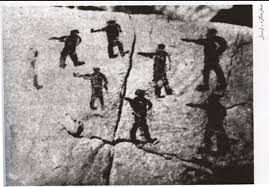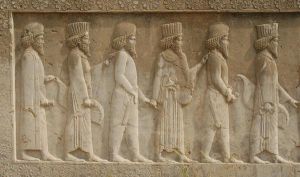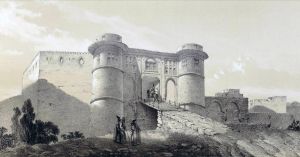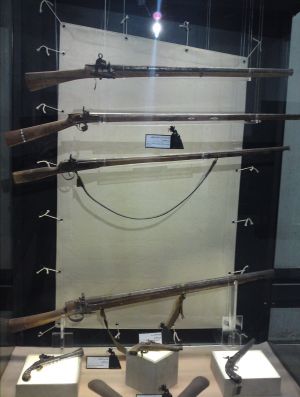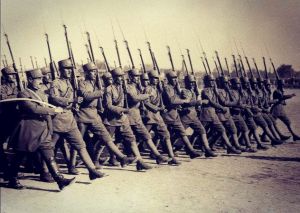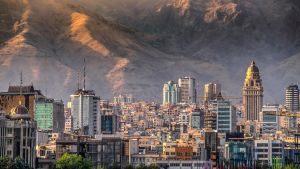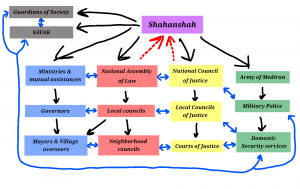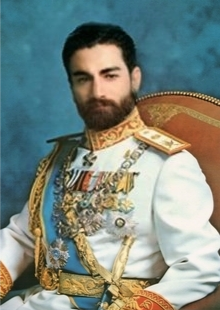Mediran (Pacifica)
Shahanshahi of Mediran شاهنشاهی مِدیران (Parsik) Shāh-an-shāhi-ye Medirān | |
|---|---|
Motto: "!قلعه ما فرو نخواهد ریخت" Ghale'e-ye mā forou nakhāhad rikht (Austral: "Our castle shall not fall!") | |
Anthem: "ملت مقاومت" Mel'lat-e-Mōghāvemat (Austral: "Nation of Resistance") | |
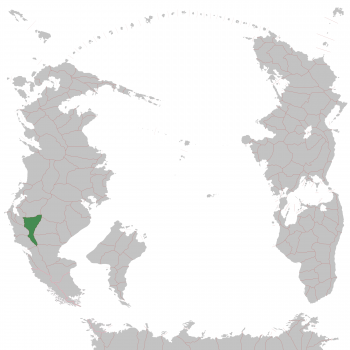 Location of Mediran | |
| Capital | Nahavand |
| Official languages | Parsik (Governmental Language) Luri (Main language) |
| Recognised regional languages | Karnik Dari |
| Ethnic groups | Lur 87% Pars 10% Karni 2.8% Others 0.2% |
| Religion | Danialism 92% Naturism 4% Paganism 2% Others 2% |
| Demonym(s) | Mediranian Pahlavi (Historical) Lurian (Incorrectly used by colonial powers) |
| Government | Unitary Progressive Socio-Monarchy |
• Shahanshah | Danial III |
• National Assembly of Law Speaker | Hooshang Partovi |
• Chief Justice | Omid Pahlavi |
| Legislature | National Assembly of Law |
| Establishment | |
• Appointment of First Marzoban | 23 CE |
• Establishment of Duchy of Pahlav | 228 CE |
• Autonomy of Duchy of Pahlav | 623 CE |
• Pahlavshahi of Nahavand | 638 CE |
• Shahanshahi of Mediran | 702 CE |
| Area | |
• Total | 148,195 km2 (57,218 sq mi) |
| Population | |
• 2021 estimate | 17,810,000 |
• 2020 census | 17,582,685 |
• Density | 118/km2 (305.6/sq mi) |
| GDP (nominal) | 2019 estimate |
• Total | $1.05 trillion |
• Per capita | $57,142 |
| Gini | 21.6 low |
| HDI | 0.942 very high |
| Currency | Derik (دِریک) (DRK) |
| Time zone | UTC-2 |
| Date format | yyyy/mm/dd (DN) |
| Driving side | right |
| Calling code | +98 |
| Internet TLD | .mdr |
Mediran (Parsik: مِدیران Medirān), also called Pahlavia, and officially the Shahanshahi of Mediran, is a nation in Southwestern Cordillia. It is bordered to the northwest by West Newt, to the north by New Itomorri, to the northeast by Huawan, to the southwest by Tekarai, to the southeast by Rebeltopia & Lucens Aurum. Mediran covers an area of 148,195 km2 (57,218 sq mi), with a population of 17.5 million. Its capital and largest city is Nahavand.
Name
The name of Mediran has roots in ancient history. Long time before the appointment of first marzoban, there was two great empires ruling the lands of today Mediran. First one was Empire of Media, which was destroyed by the next generation of emperors, Parses. After that they established the Parsik Empire, which was mostly destroyed by the Arjis, nomads of south. Pahlav survived both events, and after that, Shahanshah Danial I, decided to name the nation after the two empires. Media + Eriana (Secondary name of Parsik Empire) = Mediran.
Before and even after that, most of Foreign powers referred to Mediran (also Eriana) as Parsika or Luriana, which was (and still is) incorrect.
Because Parsika & Luriana were two separate provinces inside the empires, and not the whole country.
Even though the pronunciation in Austral is different, Mediran is the most correct way to name this nation; but calling it Pahlavia is also correct.
History
Prehistory
Ancient Mediranian people used to live on mountains for a long time, but after the invention of subterranean (Ghanāt) they began agriculture in and around the Pahlav. Isolated cave families started to gather in villages and eventually they started mining metals.
Soon after, trade begun and turned villages into towns. During the Bronze Age, the territory of present-day Mediran was home to several civilizations, including Leilam, Giroft, and Zayanderud.
Classical antiquity
The unification of the Median tribes under king Daioces in 728 BCE led to the foundation of the Median Empire which, by 612 BCE, controlled almost the entire territory of present-day Mediran and eastern Parsika.
In 2 BCE, Shahpur the Great, the son of Mandane and Cambyses I, took over the Median Empire, and founded the Parsik Empire by unifying other city-states.
The conquest of Media was a result of what is called the Parsik Revolt.
In 23 CE, Shahpur created the Marzobani system similar to today's federation.
Therefore, Marzobani of Pahlav has been created.
As the Parsik Empire grew quite larger than any other country in region, it began to decline.
Shahanshahs got more tyrant, until the arrival of Anushahrban the Wise in 623 CE.
He gave more autonomy and power to Marzobanis, but some corrupt courtiers and generals started to scheme against him. They turned his son, Govad, against him and made him kill his father in bed.
After that, the whole empire went into chaos.
Coups, uprisings, declarations of independence...
Shah after shah, nobody could last long on the throne.
Finally in 634 CE, Arji nomads that were organized under some "Prophet of god", invaded the Parsik Empire.
With the military being corrupt and unprepared due to civil wars, the great army of Parsik got defeated many times until nothing left.
In 638 CE, Marzoban Piroozan declared independence from Parsik Empire.
Cleverly, he didn't send any reinforcements to the Parsik Empire nor did he participated in civil wars.
With a loyal people, a prepared army, and an impregnable castle, he held off the Arjis and managed to survive the invasion.
Decades later, when civil war broke out in Arjistan, Shah Danial I managed to take back most of territories occupied by Arjis and he executed them all.
Then he called himself Shahanshah (King of the Kings) and Called his nation Shahanshahi of Mediran.
Medieval period
Shahanshahi of Mediran faced some invasions from neighbors during the medieval times, but it defeated them all.
Shahanshah Danial I ordered to build castles and outposts all over the mountains to keep the enemies and invaders away. It was proven a very brilliant idea when invasions began.
As Mediran stabilized more territories, it managed to maintain a powerful military with defensive agenda.
Mediranian military started to invent better and heavier weapons in order to keep the country safe.
Naturism grow in the nation and people started to plant more trees and hunt less.
With enough resources and aids provided to Farmers and Garden keepers, Mediran had an agricultural boom and as a result they never faced famines.
Early modern period
After discovering gunpowder and hydrologic power, Mediran started to improve its industry, as well as keeping the nature safe from its harmful productions. Cannons, gunpowder guns and steam powered vehicles were made, castles were replaced by concrete fortresses and traditional houses with more complex ones. Cities grow as well as villages, making the whole country more economically powerful.
Mediran started to contact with neighbors as they got pacified over time, making international trades possible.
As a result, Mediran could push the colonizers back into the seas. After several attempts of naval invasions were defeated by Mediranian army, colonial powers withdrew in shame.
During Great War
As Mediran was bordered to Tekarai during the Great war, Tekarai tried to invade Mediran to use its resources and strategic position against allies. This invasion was doomed to fail, as Mediranian army had a very good defensive line and better grounds. Even though Mediran declared neutrality during the Great War, Tekarai launched a "Surprise" attack on Mediran, which was being expected by Mediranians.
Tekarai knew that it's impossible to cross the mountains, so it tried to do an airborne invasion, as well as naval invasion. Both failed due to heavy anti-air, anti-naval guns and cannons.
After the defeated attempt of invasion, Tekarai never tried to invade Mediran again, yet border skirmishes continued.
As Tekarai surrendered to allies at 1954, Mediran excepted for war reparations but allies seized all the money and it never reached Mediran. It had negative effects on relationships between Mediran and allies.
Until today
Shahanshahi of Mediran continued its researches and established a great aerial power, as well as missle & Anti-missle warfare.
A few small rebellions broke out, which was a result of internet propaganda of communism and fascism, they were soon pacified as most of the rebels were clueless teenagers.
As a result of socialistic economic system and great efforts of people and politicians, Shahanshahi of Mediran maintains a strong economy and an excellent welfare system.
Geography
Government & Politics
The politics of Mediran take place in a framework that officially combines elements of progressive socialism and constitutional monarchy. Mediran is a Progressive Socio-Monarchy in which the Shahanshah, parliament (NAL) and judicial system share powers reserved to the national government, according to its Constitution.
Shahanshah
The Shahanshah ("Shahanshah Mediamehr") is responsible for delineation and supervision of the policies of the Shahanshahi of Mediran. The current Shahanshah, Danial III, has been issuing decrees and making the final decisions on the economy, environment, foreign policy, education, national planning, and everything else in the country.
Ministers are selected with the Shahanshah Danial's appointment and he has the ultimate say on Mediran's foreign policy.
The budget bill for every year, as well as withdrawing money from the National Development Fund of Mediran, require Shahanshah Danial's approval and permission. The Shahanshah can order laws to be amended.
The Shahanshah is the commander-in-chief of the armed forces, controls the military intelligence and security operations, and has sole power to declare war or peace.
The heads of the judiciary, national assembly of law, the state media, intelligence organizations, the commanders of the police and military forces are directly appointed by the Shahanshah.
The Assembly of Elites which consists of some members of NAL & NCJ, is responsible for supervising the Shahanshah, and has the power to dethrone him on the basis of qualifications and popular esteem.


